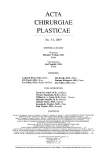UNSUCCESSFUL THERAPY OF COMBINED MYCOTIC INFECTION IN A SEVERELY BURNED PATIENT: A CASE STUDY
Authors:
B. Lipový 1; H. Řihová 1; M. Hanslianová 2; I. Kocmanová 2; Z. Žaloudíková 1; Y. Kaloudová 1; I. Suchánek 1; R. Mager 1; H. Krupicová 1; M. Slezák 3; M. Ďatko 4; P. Brychta 1; A. Ševčíková 2
Authors‘ workplace:
Department of Burns and Reconstructive Surgery , University Hospital, Brno
1; Department of Clinical Microbiology, University Hospital, Brno
2; Department of Anesthesiology and Resuscitation, University Hospital, Brno, and
3; Institute of Forensic Medicine, Brno, Czech Republic
4
Published in:
ACTA CHIRURGIAE PLASTICAE, 51, 3-4, 2009, pp. 83-84
INTRODUCTION
Critical burn trauma is always complicated by infection, particularly bacterial. However, lately we have seen a significant growth in infections caused by fungi. Mycotic infection is especially associated with neutropenic hemato-oncology patients. Patients with severe burns on more than 20% of TBSA have a specifically altered function of the immune system which is a risk factor for the occurrence of mycotic infections.
CASE STUDY
On December 11th 2008 a 30-year-old patient with polytrauma was admitted to the Burn and Reconstructive Surgery Clinic. The mechanism of injury was that the patient had to jump from 10 meters due to fire in her apartment; she could not have escaped otherwise. The patient was intubated on-site and underwent primary treatment at the surgical department in Usti nad Orlici. Next, the patient was airlifted to the Faculty Hospital in Brno, where a full body CT scan was performed. The result was severe PNO on the right side and fracture of the right wrist. Primary treatment in the operating room revealed the extent of the burn injury - 82% TBSA (75% deg III and 7% deg IIb). We completed release cuts in the area of circular burn areas. We provided good quality venous access via the right internal jugular vein and inserted a chest drain. Massive fluid resuscitation followed at the Intensive Care Unit. Brochoscopically the patient was diagnosed with inhalation trauma.
On December 19th, 2008 (+eight days) Candida albicans was isolated from the removed vein catheter and, based on the sensitivity, the patient was started on fluconazole. The first finding of the filamentous fungi was from a lower extremities smear on 22nd December, 2008 (+eleven days): it was Aspergillus fumigatus a Fusarium sp. Next, despite the targeted antimycotic therapy, on December 12th 2008 (+15 days) strains of Aspergillus fumigatus a Absidia sp. were found areas of the lower extremities and the lower back, and the only treatment option was amphotericin B. Therefore the patient was started on ABLC (amphotericin B lipid complex). Plasmatic level of galactomannan as a potential marker of invasive aspergilosis (Graph 1) was monitored in regular intervals.

To supplement information about the status of the patient we also list inflammatory markers dynamics data since the beginning of filamentous fungi isolation from lower extremities (Graph 2, 3).


Immediately after the patient was started on amphotericin B the levels of galactomannan lowered; however, afterwards they rose again. From December 26th, 2008 (+15 days) the micromycetes Absidia sp., Aspergillus fumigatus were isolated from the necrectomized areas. Since December 12th 2008 (+15 days) micromycetes Absidia sp. and Aspergillus fumigatus were isolated from the necroectomized areas in still larger amounts, despite fluctuation of the galactomannan values.
- Concurrently with the mycotic infection the patient was at first colonized and then infected by the bacterial strains of Coagulase-negative staphylococci, Enterococcus faecalis and faecium, Klebsiella pneumoniae, Pseudomonas aeruginosa. The initial, reasonably sensitive strain Pseudomonas aeruginosa was then replaced by multiresistant hospital strain pseudomonas sensitive only to Colistin.
- On January 23rd 2009 (+43 days) the patient died due to severe sepsis caused by multiresistant Pseudomonas aeruginosa.
Autopsy: Multiorgan system failure without proved invasion of mycotic strains.
DISCUSSION AND CONCLUSION
We described a case of rare combined mycotic infection in a severely burned patient without neutropenia, which despite early diagnostics and targeted treatment ended in the death of the patient due to severe sepsis, not mycotic, but of pseudomonas etiology. The case study also shows the difficulties in treatment of fungal infection localized in the burned and the necroectomy areas. The autopsy confirmed that the choice of ABLC as and antimycotic treatment was correct, but showed progress of the non-influenceable, multiresistant, pseudomonas sepsis caused by selective pressure of the administered antibiotics in this patient.
Severely
burned patients are compromised by mycotic infections!
Combined
mycotic infection is not only the domain of neutropenic patients!
Address for correspondence:
B. Lipový, M.D.
Department
of Burns and Reconstructive Surgery
Faculty Hospital Brno
Jihlavská
20
625
00 Brno
Czech Republic
E-mail:
b.lipovy@seznam.cz
Sources
1. Herndon DN. Total Burn Care 3rd Edition. Philadelphia: Saunders Elsevier, 2007, p.136-177.
2. Königová R. et al. Komplexní léčba popálenin. Praha: Grada, 1999, p. 285-299.
3. Constantinides J, Misra A, Nassab R, Wilson Y. Absidia corymbifera fungal infection in burns: a case report and review of the literature. J. Burn Care Res., 29(2), 2008, p. 416-419.
4. Ribes JA, Vanover-Sams CL, Baker DJ. Zygomycetes in human disease. Clin. Microbiol. Rev., 13(2), 2000, p. 236-301.
Labels
Plastic surgery Orthopaedics Burns medicine TraumatologyArticle was published in
Acta chirurgiae plasticae

2009 Issue 3-4
Most read in this issue
- BREAST DESMOID TUMOR AFTER AUGMENTATION MAMMOPLASTY: TWO CASE REPORTS
- VACUUM-ASSISTED CLOSURE DOWNGRADES RECONSTRUCTIVE DEMANDS IN HIGH-RISK PATIENTS WITH SEVERE LOWER EXTREMITY INJURIES
- THE HISTORY OF CLEFT PALATE SURGERY AT THE DEPARTMENT OF PLASTIC SURGERY IN PRAGUE
- UNSUCCESSFUL THERAPY OF COMBINED MYCOTIC INFECTION IN A SEVERELY BURNED PATIENT: A CASE STUDY
